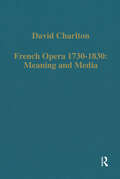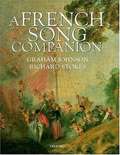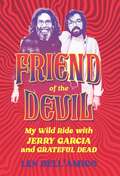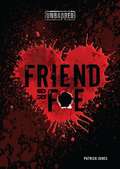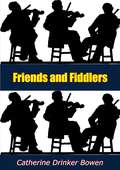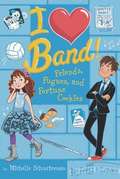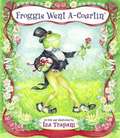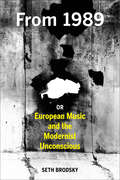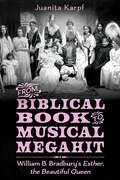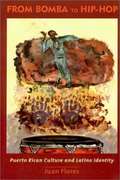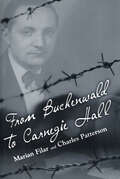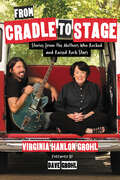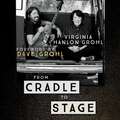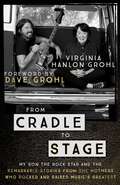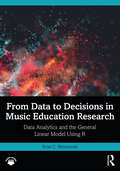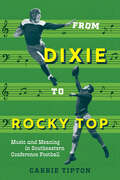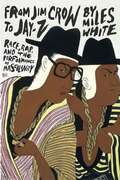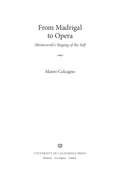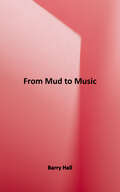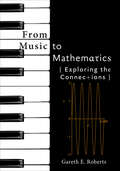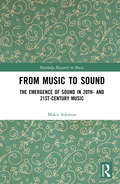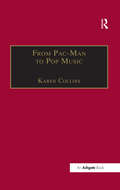- Table View
- List View
French Opera 1730-1830: Meaning and Media (Variorum Collected Studies)
by David CharltonThe majority of these collected essays date from 1992 onwards, three of them having been specially expanded for this volume. Drawing on recent archival research and new musicological theory, they investigate distinctive qualities in French opera from early opéra comique to early grand opera. ’Media’ is interpreted in terms of both narrative systems and practical theatre resources. One group of essays identifies narrative systems in ’minuet-scenes’, in the diegetic romance, and in special uses of musical motives. Another group concerns the theory and æsthetics of opera, in which uses of metaphor help us interpret audience reception. A third group focuses on orchestral and staging practices, brought together in a new theory of the 'melodrama model’ linking various genres from the 1780s with the world of the 1820s. French opera’s relation with literature and politics is a continuing theme, explored in writings on prison scenes, Ossian, and public-private dramaturgy in grand opera. David Charlton has written widely on French music and opera topics for over 25 years. The selection of his articles presented here focuses on the period 1730-1830 when Paris was a hotbed of influential ideas in music and music theatre, with many of these ideas taken up by foreign composers. This volume assesses the French contribution to the development of Classical and Romantic styles and genres which has hitherto not received the attention it deserves.
A French Song Companion
by Graham Johnson Richard StokesThis is the most comprehensive book of French mélodie (French art-song) in any language. Graham Johnson, a noted authority on song, provides repertoire guides to the work of some 150 composers who have written French vocal music. There are major articles on such figures as Fauré, Duparc, Debussy, Ravel, and Poulenc; substantial articles on Bizet, Chabrier, Gounod, Chausson, Hahn, and Satie; and reassessments of such composers as Massenet, Koechlin, and Leguerney. The biographical articles are supplemented by the song translations of Richard Stokes, some 700 in all, and a veritable treasury of great French poetry from the fifteenth to the twentieth centuries. These are indispensable to music lovers, concert-goers, and professional singers and their accompanists. Graham Johnson is one of the most distinguished vocal accompanists of our time. Recital appearances with many great singers--from Schwarzkopf and De los Angeles to Margaret Price and Christine Schäfer, from Peter Pears to Anthony Rolfe-Johnson, Peter Schreier, and Ian Bostridge, from François Le Roux to Thomas Hampson and Matthias Goerne--have been supplemented by a prodigious recording career: the complete Schubert Lieder on 37 CDs for Hyperion, with a similar exhaustive Schumann project already underway; an ongoing edition of French song recordings, also for Hyperion; numerous recordings of English song composers (recently Britten and John Ireland); duet recitals with Felicity Lott and Ann Murray (on EMI); and discs of songs by such composers as Dvorák, Janácek, Martinu, and Musorgsky. Richard Stokes, the translator of the songs, teaches languages at Westminster School, London, coaches singers in the interpretation of Lieder, and gives frequent lectures on song composers. He is the co-author of books on German and Spanish song (The Fischer-Dieskau Book of Lieder and The Spanish Song Companion) and has just published J. S. Bach--The Complete Church and Secular Cantatas (Long Barn Books). Below each line of French is a line of English translation. In addition, DAISY markup sets each composer at level 1 and each song at level 2, facilitating navigation through the book. The web site Hyperion-Records.co.uk contains pdf files of the many booklets of songs and commentary produced by Graham Johnson and Richard Stokes, free for downloading, including the complete Schubert songs and many of the song composers listed above.
Friend of the Devil: My Wild Ride With Jerry Garcia and Grateful Dead
by Len Dell'AmicoThe inside story of Jerry Garcia and Grateful Dead from one of the few non-band members allowed in the band's inner circle: videographer, Len Dell'Amico. From 1980 to 1995, he witnessed brilliance, love, happy chaos, and pot. Lots of pot. This a story of Jerry Garcia and Grateful Dead from the band&’s videographer of 15 years, Len Dell&’Amico. He was one of the few non-band members allowed into their inner circle. At a time of tremendous creative growth and record sales, Dell&’Amico found himself at Garcia&’s side as a trusted voice while Grateful Dead became a force in the 1980s. Using his skills as a multi-camera live video director, the band and Dell&’Amico were able to create amazing concert films and music videos. Along the way, Jerry Garcia flashed his genius, eccentricity, generosity of spirit, and emotional depth through his music and relationships with the crew. Friend of the Devil is a rare look at Grateful Dead and how beloved Jerry Garcia was before he passed away at the age of 53.
Friend or Foe (Unbarred)
by Patrick JonesDo the crime, do the time behind bars. But once you've been in, it can be tough to stay out. Ian's band is finally taking off. But the band's front man and Ian's best friend, Orlando, can't catch a break as a black kid in their white town. Tension with a security guard lands both Ian and Orlando in jail, and when Orlando is held indefinitely, someone will need to take over the band until he gets out. When Orlando chooses Chase, the band's bassist, to step in, Ian is slighted. As Ian's resentment builds, he plots his revenge. One by one, he turns his bandmates against one another, with tragic results. As Ian holds his friends close and his enemies closer, no one can tell which is which—until it's too late.
Friends and Fiddlers: Memoirs
by Catherine Drinker BowenCatherine Drinker Bowen was a Philadelphian with music in her veins....Into this book she has crammed the joy, comedy, and desperation of a musical life. With the skill of a biographer she sums up the human equation in music with insatiable enthusiasm. She discourses on amateur quartets, fiddlers, wild-eyed cellists, wives who play violas and children who bang the box.This is a book which musicians will chortle over, a book which the layman will read with dawning delight.
Friends, Fugues, and Fortune Cookies #2
by Genevieve Kote Michelle SchustermanBand Geeks unite in this fresh new middle-grade series by debut author (and former band director) Michelle Schusterman! The band's bake-sale fund-raiser pits the sections against each other, and Holly is positive the brass section will win. After all, the two most competitive kids in band are Holly and Natasha. When Holly hears a rumor that Aaron Cook is going to ask her to the winter dance, she's ecstatic. So when Aaron asks Natasha to the dance, Holly thinks she can't feel much worse. When a small disaster sets the brass section way behind in the band's bake sale, Holly gets a brilliant idea that's guaranteed to help them win--and with a little good fortune, it might save Holly's friendship with Natasha, too!
Fritz Reiner, Maestro and Martinet
by Kenneth MorganThis award-winning book, now available in paperback, is the first solid appraisal of the legendary career of the eminent Hungarian-born conductor Fritz Reiner (1888-1963). Personally enigmatic and often described as difficult to work with, he was nevertheless renowned for the dynamic galvanization of the orchestras he led, a nearly unrivaled technical ability, and high professional standards. Reiner's influence in the United States began in the early 1920s and lasted until his death. Reiner was also deeply committed to serious music in American life, especially through the promotion of new scores. In Fritz Reiner, Maestro and Martinet, Kenneth Morgan paints a very real portrait of a man who was both his own worst enemy and one of the true titans of his profession.
Froggie Went A-Courtin'
by Iza TrapaniAn adaptation of the folk song about a frog in search of a bride.
Froggy Plays in the Band
by Jonathan LondonHere comes Froggy's marching band, led by the one and only Frogilina. Froggy and his pals are sure they can win the big prize in the Apple Blossom Parade, even though they haven't been playing together very long. They just need to remember the rules: Don't look left. Don't look right. And DONT STOP FOR ANYTHING! But when Froggy's around, things never go quite as planned... Limited picture descriptions added.
From 1989, or European Music and the Modernist Unconscious
by Seth BrodskyWhat happened to musical modernism? When did it end? Did it end? In this unorthodox Lacanian account of European New Music, Seth Brodsky focuses on the unlikely year 1989, when New Music hardly takes center stage. Instead one finds Rostropovich playing Bach at Checkpoint Charlie; or Bernstein changing “Joy” to “Freedom” in Beethoven’s Ninth; or David Hasselhoff lip-synching “Looking for Freedom” to thousands on New Year’s Eve. But if such spectacles claim to master their historical moment, New Music unconsciously takes the role of analyst. In so doing, it restages earlier scenes of modernism. As world politics witnesses a turning away from the possibility of revolution, musical modernism revolves in place, performing century-old tasks of losing, failing, and beginning again, in preparation for a revolution to come.
From Biblical Book to Musical Megahit: William B. Bradbury's Esther, the Beautiful Queen
by Juanita KarpfMany churchgoers will recognize the name William Bradbury, a nineteenth-century American composer of popular hymns still sung at Sunday services. Bradbury’s name may also bring to mind Esther, the Beautiful Queen, his choral setting of a text based on the biblical Book of Esther. The uncomplicated score became enormously popular almost immediately after its initial publication in 1856. In From Biblical Book to Musical Megahit: William B. Bradbury’s “Esther, the Beautiful Queen,” Juanita Karpf traces the work’s rich performance and reception history. Bradbury emphatically stated that he intended Esther to be sung as an unadorned religious and educational piece. Yet many music directors exploited the potential for his score, producing elaborately staged events with costumes, scenery, and acting. Although directors retained Bradbury’s original music, they nonetheless facilitated Esther’s rapid entrée into the realm of music theater. This stylistic transformation ignited a firestorm of controversy. Some clergy and religiously pious citizens condemned theatrical representations of biblical texts as the epitome of debauchery, sacrilege, and sin. In contrast, more tolerant and open-minded theater enthusiasts welcomed the dramatic staging of Esther as wholesome entertainment and as evidence of a refreshingly enlightened approach to biblical interpretation. However heated this debate seemed at times, it did little to quell the continued rise in popularity of Esther. In fact, by the late 1860s, Bradbury’s score had worked its way across the continent, north to Canada and, eventually, to Great Britain, Australia, Asia, and Africa. With performances recorded over a century after Bradbury published his score, Esther became, by any measure, an international megahit.
From Bomba to Hip-Hop: Puerto Rican Culture and Latino Identity (Popular Cultures, Everyday Lives)
by Juan FloresJuan Flores considers the uniqueness of Puerto Rican culture and identity in relation to that of other Latino groups in the United States--as well as to other minority groups, especially African Americans. Architecture and urban space, literary traditions, musical styles, and cultural movements provide some of the sites and moments of a cultural world defined by the interplay of continuity and transformation, heritage and innovation, roots and fusion. Exploring this wide range of cultural expression--both in the diaspora and in Puerto Rico--Flores highlights the rich complexities and fertile contradictions of Latino identity.
From Buchenwald to Carnegie Hall (Willie Morris Books in Memoir and Biography)
by Marian Filar Charles PattersonBefore the Nazis sent members of the Filar family to Treblinka, these were the last words Marian Filar's mother said to him: “I bless you. You'll survive this horror. You'll become a great pianist, and I'll be very proud of you.” Born in 1917 into a musical Jewish family in Warsaw, Filar began playing the piano when he was four. He performed his first public concert at the age of six. At twelve he played with the Warsaw Philharmonic Orchestra and went on to study with the great Polish pianist and teacher Zbigniew Drzewiecki at the State Conservatory of Music. After the German invasion, Filar fled to Lemberg (Lvov), where he continued his music studies until 1941, when he returned to his family in the Warsaw Ghetto. The Nazis killed his parents, a sister, and a brother, but he and his brother Joel survived as workers on the German railroad. After taking part in the Warsaw Ghetto uprising, Marian and Joel were captured and sent to Majdanek, Buchenwald, and other concentration camps. After liberation Filar was able to resume his career by studying with the renowned German pianist Walter Gieseking. In 1950 he immigrated to the United States and soon after was performing concerts with Eugene Ormandy and the Philadelphia Orchestra. He made his Carnegie Hall debut on New Year's Day, 1952. He became head of the piano department at the Settlement Music School in Philadelphia and later a professor of music at Temple University, while continuing to perform in Europe, South America, Israel, and the United States. Filar does not end his story with liberation but with the fulfillment of his mother's blessing. Without rancor or bitterness, his memoir comes full circle, ending where it began—in Warsaw. In 1992 Filar traveled to Poland to visit the school next to what had once been the Umschlagplatz, the place from which Jews had been sent to Treblinka and where he said farewell to the mother who blessed him.
From Cradle to Stage: Stories from the Mothers Who Rocked and Raised Rock Stars
by Virginia Hanlon GrohlWhile the Grohl family had always been musical-the family sang together on long car trips, harmonizing to Motown and David Bowie-Virginia never expected her son to become a musician, let alone a rock star. But when she saw him perform in front of thousands of screaming fans for the first time, she knew that rock stardom was meant to be for her son. And as Virginia watched her son's star rise, she often wondered about the other mothers who raised sons and daughters who became rock stars. Were they as surprised as she was about their children's fame? Did they worry about their children's livelihood and wellbeing in an industry fraught with drugs and other dangers? Did they encourage their children's passions despite the odds against success, or attempt to dissuade them from their grandiose dreams? Do they remind their kids to pack a warm coat when they go on tour? Virginia decided to seek out other rock star mothers to ask these questions, and so began a two-year odyssey in which she interviewed such women as Verna Griffin, Dr. Dre's mother; Marianne Stipe, Michael Stipe of REM's mother; Janis Winehouse, Amy Winehouse's mother; Patsy Noah, Adam Levine's mother; Donna Haim, mother of the Haim sisters; Hester Diamond, Mike D of The Beastie Boys' mother. With exclusive family photographs and a foreword by Dave Grohl, From Cradle to Stage will appeal to mothers and rock fans everywhere.
From Cradle to Stage: Stories from the Mothers Who Rocked and Raised Rock Stars
by Virginia Hanlon GrohlFrom Cradle to Stage shares stories and exclusive photos featuring mothers of rock icons, the icons themselves, and their Behind the Music-style relationshipsWhile the Grohl family had always been musical-the family sang together on long car trips, harmonizing to Motown and David Bowie, Virginia Grohl never expected her son to become a musician, let alone a rock star. But when she saw him perform in front of thousands of screaming fans for the first time, she knew that stardom was meant to be for her son. And as Virginia watched her son's star rise, she often wondered about the other mothers who raised children who became rock stars. Were they as surprised as she was about their children's fame? Did they worry about their children's livelihood and well-being in an industry fraught with drugs and other dangers? Did they encourage their children's passions despite the odds against success, or attempt to dissuade them from their grandiose dreams? Do they remind their kids to pack a warm coat when they go on tour?Virginia decided to seek out other celebrity mothers to ask these questions, and so began a two-year odyssey in which she interviewed such women as Verna Griffin, Dr. Dre's mother; Marianne Stipe, Michael Stipe of REM's mother; Janis Winehouse, Amy Winehouse's mother; Patsy Noah, Adam Levine's mother; Donna Haim, mother of the Haim sisters; Hester Diamond, Mike D of The Beastie Boys' mother.With exclusive family photographs and a foreword by Dave Grohl, From Cradle to Stage will appeal to mothers and music fans everywhere.(P)2017 Hachette Audio
From Cradle to Stage: Stories from the Mothers Who Rocked and Raised Rock Stars
by Virginia Hanlon GrohlVirginia Grohl, mother of Dave Grohl, had not seen any of it coming. Not the arenas of screaming fans, not Nirvana or the Foo Fighters, not the induction into the Rock and Roll Hall of Fame, and certainly not her son, Dave, performing with Sir Paul McCartney at The White House. Theirs had always been a life full of music - the Grohl family sang together on long car trips, harmonising to Motown and David Bowie - yet Virginia never expected her son to become a musician. But when Virginia saw Nirvana play for the first time to crazed applause from thousands of screaming fans, she knew nothing would ever be the same. She was the mother of a rock star.And as Virginia watched her son's star rise, she often wondered about the other mothers who raised sons and daughters who became rock stars. Were they as surprised as she was about their children's fame? Virginia often wondered about the mystical force that urges some of us to listen, to play, to surround ourselves with music. She wanted to talk about it with the other mothers whose sons and daughters were sharing stages with Dave, and she decided to seek them out wherever they were. So began a two-year odyssey, where she had conversations with such women from all over the world as Verna Griffin, Dr Dre's mother, Carolyn Williams, Pharell William's mother, Janis Winehouse, Amy Winehouse's mother, Patsy Noah, Adam Levine's mother, Donna Haim, mother to the Haim sisters and Hester Diamond, Mike D of The Beastie Boys' mother, to name just a few. From Cradle to Stage will appeal to mothers everywhere, but particularly to those with children who march (or play) to the beat of their own drum; and it's for those children who have their mothers to thank for everything. For music lovers and rock fans, it's the ultimate backstage pass-for anyone who has wondered what it's like to be on the inside...looking out at a packed arena. Featuring a foreword by Dave Grohl and exclusive family photographs, interviews are interwoven with the Grohl family story and the resultant book is a very intimate portrait of what makes a rock star.
From Data to Decisions in Music Education Research: Data Analytics and the General Linear Model Using R
by Brian C. WesolowskiFrom Data to Decisions in Music Education Research provides a structured and hands-on approach to working with empirical data in the context of music education research. Using step-by-step tutorials with in-depth examples of music education data, this book draws upon concepts in data science and statistics to provide a comprehensive framework for working with a variety of data and solving data-driven problems. All of the skills presented here use the R programming language, a free, open-source statistical computing and graphics environment. Using R enables readers to refine their computational thinking abilities and data literacy skills while facilitating reproducibility, replication, and transparency of data analysis in the field. The book offers: A clear and comprehensive framework for thinking about data analysis processes in a music education context. An overview of common data structures and data types used in statistical programming and data analytics. Techniques for cleaning, preprocessing, manipulating, aggregating, and mining data in ways that facilitate organization and interpretation. Methods for summarizing and visualizing data to help identify structures, patterns, and trends within data sets. Detailed applications of descriptive, diagnostic, and predictive analytics processes. Step-by-step code for all concepts and analyses. Direct access to all data sets and R script files through the accompanying eResource. From Data to Decisions in Music Education Research offers a reference "cookbook" of code and programming recipes written with the graduate music education student in mind and breaks down data analysis processes and skills in an approachable fashion. It can be used across a wide range of graduate music education courses that rely on the application of empirical data analyses and will be useful to all music education scholars and professionals seeking to enhance their use of quantitative data.
From Data to Decisions in Music Education Research: Data Analytics and the General Linear Model Using R
by Brian C. WesolowskiFrom Data to Decisions in Music Education Research provides a structured and hands-on approach to working with empirical data in the context of music education research. Using step-by-step tutorials with in-depth examples of music education data, this book draws upon concepts in data science and statistics to provide a comprehensive framework for working with a variety of data and solving data-driven problems.All of the skills presented here use the R programming language, a free, open-source statistical computing and graphics environment. Using R enables readers to refine their computational thinking abilities and data literacy skills while facilitating reproducibility, replication, and transparency of data analysis in the field. The book offers: A clear and comprehensive framework for thinking about data analysis processes in a music education context. An overview of common data structures and data types used in statistical programming and data analytics. Techniques for cleaning, preprocessing, manipulating, aggregating, and mining data in ways that facilitate organization and interpretation. Methods for summarizing and visualizing data to help identify structures, patterns, and trends within data sets. Detailed applications of descriptive, diagnostic, and predictive analytics processes. Step-by-step code for all concepts and analyses. Direct access to all data sets and R script files through the accompanying eResource. From Data to Decisions in Music Education Research offers a reference "cookbook" of code and programming recipes written with the graduate music education student in mind and breaks down data analysis processes and skills in an approachable fashion. It can be used across a wide range of graduate music education courses that rely on the application of empirical data analyses and will be useful to all music education scholars and professionals seeking to enhance their use of quantitative data.
From Dixie to Rocky Top: Music and Meaning in Southeastern Conference Football
by Carrie TiptonThe first book to explore the history of college fight songs as a culturally important phenomenon, From Dixie to Rocky Top zeroes in on the US South, where college football has forged a powerful, quasi-religious sense of meaning and identity throughout the region. Tracing the story of Southeastern Conference (SEC) fight songs from the late nineteenth to the early twenty-first century, author Carrie Tipton places this popular repertory within the broader commercial music industry and uses fight songs to explore themes of authorship and copyright; the commodification of school spirit; and the construction of race, gender, and regional identity in Southern football culture. This book unearths the history embedded in SEC football&’s music traditions, drawing from the archives of the seventeen universities currently or formerly in the conference. Alongside rich primary sources, Tipton incorporates approaches and literature from sports history, Southern and American history, Southern and American studies, and musicology. Chronicling iconic Southern fight songs&’ origins, dissemination, meanings, and cultural reception over a turbulent century, From Dixie to Rocky Top weaves a compelling narrative around a virtually unstudied body of popular music.
From Jim Crow to Jay-Z: Race, Rap, and the Performance of Masculinity
by Miles WhiteThis multilayered study of the representation of black masculinity in musical and cultural performance takes aim at the reduction of African American male culture to stereotypes of deviance, misogyny, and excess. Broadening the significance of hip-hop culture by linking it to other expressive forms within popular culture, Miles White examines how these representations have both encouraged the demonization of young black males in the United States and abroad and contributed to the construction of their identities. From Jim Crow to Jay-Z traces black male representations to chattel slavery and American minstrelsy as early examples of fetishization and commodification of black male subjectivity. Continuing with diverse discussions including black action films, heavyweight prizefighting, Elvis Presley's performance of blackness, and white rappers such as Vanilla Ice and Eminem, White establishes a sophisticated framework for interpreting and critiquing black masculinity in hip-hop music and culture. Arguing that black music has undeniably shaped American popular culture and that hip-hop tropes have exerted a defining influence on young male aspirations and behavior, White draws a critical link between the body, musical sound, and the construction of identity.
From Madrigal to Opera
by Mauro CalcagnoThis pathbreaking study links two traditionally separate genres as their stars crossed to explore the emergence of multiple selves in early modern Italian culture and society. Mauro Calcagno focuses on the works of Claudio Monteverdi, a master of both genres, to investigate how they reflect changing ideas about performance and role-playing by singers. Calcagno traces the roots of dialogic subjectivity to Petrarch's love poetry arguing that Petrarchism exerted a powerful influence not only on late Renaissance literature and art, but also on music. Covering more than a century of music and cultural history, the book demonstrates that the birth of opera relied on an important feature of the madrigalian tradition: the role of the composer as a narrative agent enabling performers to become characters and hold a specific point of view.
From Mud to Music: Making and Enjoying Ceramic Musical Instruments
by Barry HallThis book is about a truly remarkable transformation: how the simplest of materials clay or mud can be used to make tools for producing one of the most complex human expressions of music. With a history reaching back to ancient times, creating ceramic musical instruments is a vibrant pursuit for many innovative artists today. From Mud to Music explores the vast array of ceramic musical instruments, from their historical traditions in world cultures to modern variations and innovations. All instrument families are represented: percussion, winds, strings, and even unique hybrids. For each type of instrument, special construction techniques specific to clay are explained. In addition, there's a chapter providing detailed, step-by-step instructions showing how to build several ceramic instruments. A companion audio CD contains 43 diverse tracks of ceramic instrumental music ranging from the refined melodic strains of Vivaldi and Tchaikovsky to the earthy, primal wailings of bizarre pre-Columbian wind instruments. Hundreds of color photos present the work of artists from around the world spanning the last 3000 years, from ancient Peruvian water whistles and Mesopotamian rattles to contemporary seven-chambered ocarinas and ceramic bagpipes. In-depth profiles explore a number of today's artists, their work, and their inspirations. Whether you are a musician, ceramist, or just a fan of art and music, you are invited to embark on an incredible journey...from mud to music!
From Music to Mathematics: Exploring the Connections
by Gareth E. RobertsA guided tour of the mathematical principles inherent in music.Taking a "music first" approach, Gareth E. Roberts's From Music to Mathematics will inspire students to learn important, interesting, and at times advanced mathematics. Ranging from a discussion of the geometric sequences and series found in the rhythmic structure of music to the phase-shifting techniques of composer Steve Reich, the musical concepts and examples in the book motivate a deeper study of mathematics.Comprehensive and clearly written, From Music to Mathematics is designed to appeal to readers without specialized knowledge of mathematics or music. Students are taught the relevant concepts from music theory (notation, scales, intervals, the circle of fifths, tonality, etc.), with the pertinent mathematics developed alongside the related musical topic. The mathematics advances in level of difficulty from calculating with fractions, to manipulating trigonometric formulas, to constructing group multiplication tables and proving a number is irrational. Topics discussed in the book include• Rhythm • Introductory music theory • The science of sound • Tuning and temperament• Symmetry in music • The Bartók controversy • Change ringing • Twelve-tone music• Mathematical modern music • The Hemachandra–Fibonacci numbers and the golden ratio• Magic squares • Phase shiftingFeaturing numerous musical excerpts, including several from jazz and popular music, each topic is presented in a clear and in-depth fashion. Sample problems are included as part of the exposition, with carefully written solutions provided to assist the reader. The book also contains more than 200 exercises designed to help develop students' analytical skills and reinforce the material in the text. From the first chapter through the last, readers eager to learn more about the connections between mathematics and music will find a comprehensive textbook designed to satisfy their natural curiosity.
From Music to Sound: The Emergence of Sound in 20th- and 21st-Century Music (Routledge Research in Music)
by Makis SolomosFrom Music to Sound is an examination of the six musical histories whose convergence produces the emergence of sound, offering a plural, original history of new music and showing how music had begun a change of paradigm, moving from a culture centred on the note to a culture of sound. Each chapter follows a chronological progression and is illustrated with numerous musical examples. The chapters are composed of six parallel histories: timbre, which became a central category for musical composition; noise and the exploration of its musical potential; listening, the awareness of which opens to the generality of sound; deeper and deeper immersion in sound; the substitution of composing the sound for composing with sounds; and space, which is progressively viewed as composable. The book proposes a global overview, one of the first of its kind, since its ambition is to systematically delimit the emergence of sound. Both well-known and lesser-known works and composers are analysed in detail; from Debussy to contemporary music in the early twenty-first century; from rock to electronica; from the sound objects of the earliest musique concrète to current electroacoustic music; from the Poème électronique of Le Corbusier-Varèse-Xenakis to the most recent inter-arts attempts. Covering theory, analysis and aesthetics, From Music to Sound will be of great interest to scholars, professionals and students of Music, Musicology, Sound Studies and Sonic Arts. Supporting musical examples can be accessed via the online Routledge Music Research Portal.
From Pac-Man to Pop Music: Interactive Audio in Games and New Media (Ashgate Popular And Folk Music Ser.)
by Karen CollinsDigital interactive audio is the future of audio in media - most notably video games, but also web pages, theme parks, museums, art installations and theatrical events. Despite its importance to contemporary multi-media, this is the first book that provides a framework for understanding the history, issues and theories surrounding interactive audio. Karen Collins presents the work of academics, composers and sound programmers to introduce the topic from a variety of angles in order to provide a supplementary text for music and multimedia courses. The contributors cover practical and theoretical approaches, including historical perspectives, emerging theories, socio-cultural approaches to fandom, reception theory and case study analyses. The book offers a fresh perspective on media music, one that will complement film studies, but which will show the necessity of a unique approach when considering games music.
